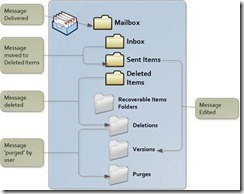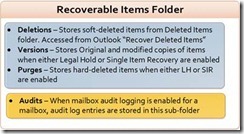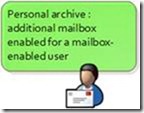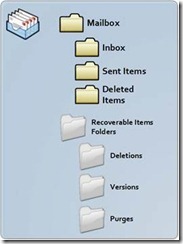Exchange 2010–Dumpster V2.0 questions and answers
Ø Does the archive database has a separate dumpster with a separate retention ?
Remember in my presentation, I talked about the dumpster v2.0 and the purposes of the “Deletions”, “Versions”, and “Purges” subfolders. Note that these will be used only if you activate the “Single Item Recovery” or the “Litigation Hold” feature on your mailboxes :
The archive mailbox, which can be either in the same database as the “live” mailbox or in a separate, dedicated database that you can chose anytime (when creating the live mailbox or you can also move the archive after a while).
So each archive mailbox is always associated with the “live” mailbox. And each archive mailbox has exactly the same Dumpster v2.0 structure than the “live” mailbox:
Ø What happens when I move an email from my inbox to the archive and then delete it.
If you move a mail from the “live” mailbox to the archive mailbox, the mail will reside in the archive mailbox. Then, if you delete it, it will go on the Dumpster V2.0 from the archive mailbox, on the “Deletions” sub-folder of the archive mailbox’ dumpster v2.0. If you chose to purge it using the “Recover deleted items” menu from Outlook, e.g :
… then the mails will go in the “Purge” items, still on the dumpster of the archive mailbox.
Ø How long would the deleted copy be kept?
- The time period by which the deleted data is maintained is based on the deleted item retention window. The default time period is 14 days in Exchange 2010 and is configurable per database or per mailbox. The following cmdlets let you alter this behavior:
o For the mailbox database: Set-MailboxDatabase -DeletedItemRetention
o For the mailbox: Set-Mailbox -RetainDeletedItemsFor
- Also, to avoid denial of service attacks by placing lot of data into the dumpster (lots of spams for example, that the user deletes), you can configure the dumpster to have a quota. By default, the database-level limits are configured for the dumpster. You can use the RecoverableItemsWarningQuota and/or the RecoverableItemsQuota parameters from the mailbox settings to set the dumpster’s quota and the behavior of the dumpster in case the quota is reached.
o Recoverable Items Warning Quota : lets the dumpster purge the oldest mails to permit new mails to be placed in the dumpster
o Recoverable Items Quota : prevents any deletions on the “live” mailbox when the dumpster’s quota is reached.
More information about all the answers given in the mail can be found on the following links :
Understanding Recoverable Items
https://technet.microsoft.com/en-us/library/ee364755(v=exchg.141).aspx
Recoverable Items Folder
https://blogs.technet.com/b/exchange/archive/2009/09/25/3408389.aspx




